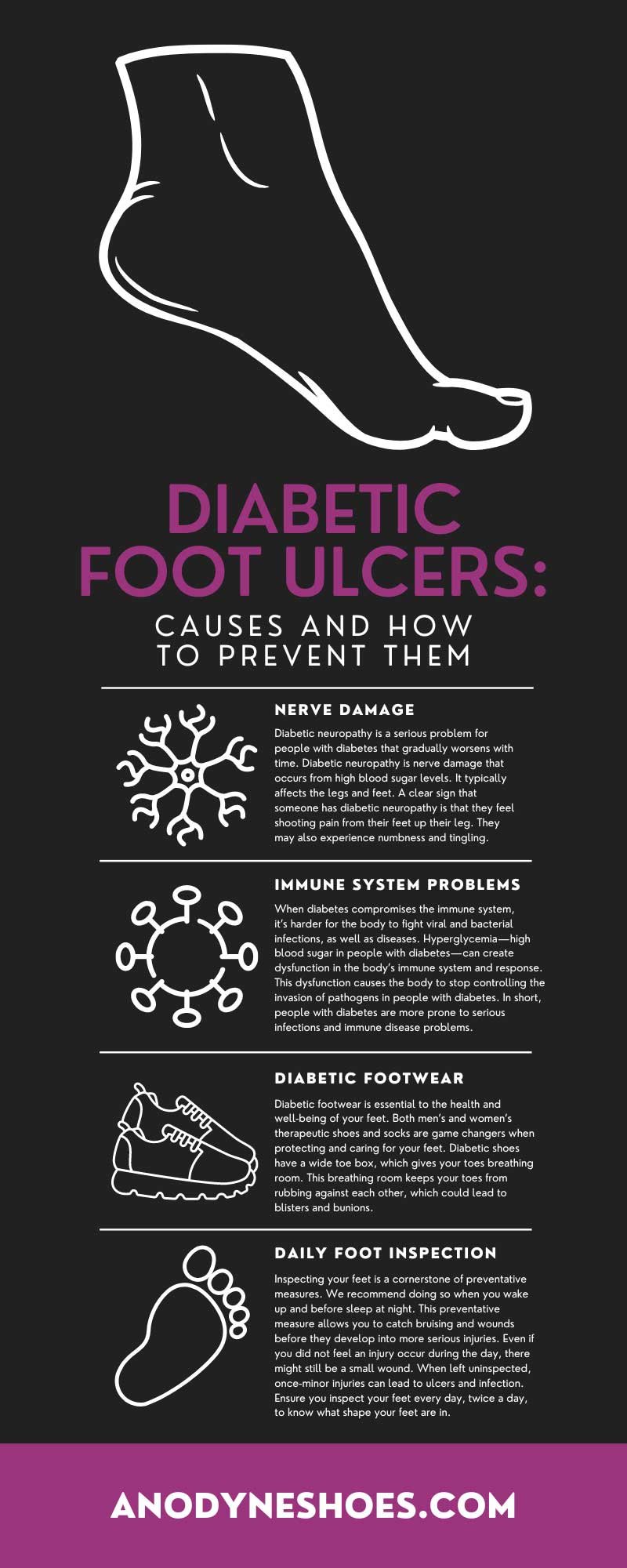%20(750%20x%20422%20px)%20(9).jpg?width=750&height=422&name=Anodyne%20Blog%20Template%20(1080%20x%201080%20px)%20(750%20x%20422%20px)%20(9).jpg)
When you have diabetes, you must learn how to care for your feet. You need to look out for many things, including bunions, corns, bruising, cuts, and of course, diabetic foot ulcers. So, what are foot ulcers? They are a serious problem for people who struggle with the condition.
This condition involves open wounds and sores on the feet—typically on the bottom or sole of the foot. They occur in about 16 percent of people who struggle with diabetes. Many people who deal with this require hospitalization because of ulcer-related complications or infections. Because of this, understanding the causes and prevention of diabetic foot ulcers is imperative for the well-being of people who deal with the condition.
High Blood Sugar Levels
High blood sugar levels are the most common cause of slow-healing ulcers. These elevated glucose levels can cause the arteries to stiffen and blood vessels to narrow. This change restricts the oxygen and blood needed to support the body’s natural healing traits, causing open wounds to heal slowly. Since blood isn’t reaching the area in question, it’s unable to clot and heal effectively.
Poor Circulation
Poor circulation results from many things, but a common culprit is inadequate footwear. Peripheral arterial disease (PAD) is a central problem as it restricts blood flow to the legs and feet. PAD is difficult for people trying to cope with diabetic foot ulcers and chronic wounds, especially since it inhibits the body’s healing ability.
Nerve Damage
Diabetic neuropathy is a serious problem for people with diabetes that gradually worsens with time. Diabetic neuropathy is nerve damage that occurs from high blood sugar levels. It typically affects the legs and feet. A clear sign that someone has diabetic neuropathy is that they feel shooting pain from their feet up their leg. They may also experience numbness and tingling.
A small cut, surgical wound, or blister can go untreated for some time for people with diabetic neuropathy. A lack of treatment can lead to foot ulcers and infections that interfere with a person’s ability to recover. With the help of your physician, you can work to prevent this condition.
Immune System Problems
When diabetes compromises the immune system, it’s harder for the body to fight viral and bacterial infections, as well as diseases. Hyperglycemia—high blood sugar in people with diabetes—can create dysfunction in the body’s immune system and response. This dysfunction causes the body to stop controlling the invasion of pathogens in people with diabetes. In short, people with diabetes are more prone to serious infections and immune disease problems.
Issues With Infection
A compromised immune system makes the body more susceptible to infection. The body cannot quickly send white blood cells to an infected ulcer, making it harder for people with diabetes to fight bacteria. This issue makes it far more likely that a person will experience an infection, which can be severe. The longer the body goes without healing—a result of the body’s inability to send white blood cells to the site of the infection—the more likely you are to have to deal with complications.
Another way the body repairs itself is to clear away damaged and dead tissue and instead build new skin cells when an injury or wound occurs. Unfortunately, diabetes can slow this process and diminish the body’s ability to rebuild.
Preventative Measures
After you figure out the causes of diabetic foot ulcers, learn to prevent them. You can do this by implementing simple lifestyle changes that will help you become better able to manage your symptoms. Learn more about the changes you can make below. These changes aren’t anything major. When you implement them in your life, they’ll become second nature.
Diabetic Footwear
Diabetic footwear is essential to the health and well-being of your feet. Both men’s and women’s therapeutic shoes and socks are game changers when protecting and caring for your feet. Diabetic shoes have a wide toe box, which gives your toes breathing room. This breathing room keeps your toes from rubbing against each other, which could lead to blisters and bunions. Additionally, they have space for custom and gel insoles, which allows you to have additional protection and support. They’re so useful that podiatrists suggest that you always wear diabetic shoes or diabetic slippers in the house. You can even get diabetic house shoes for just this purpose.
Diabetic socks provide a seamless construction with antimicrobial, sweat-wicking fabric, which is perfect for a person with diabetic neuropathy. They’re comfortable but have a firm protective layer that helps to keep your feet safe. If you want top-tier protection for your feet, diabetic footwear is the way to go.
Daily Foot Inspection
Inspecting your feet is a cornerstone of preventative measures. We recommend doing so when you wake up and before sleep at night. This preventative measure allows you to catch bruising and wounds before they develop into more serious injuries. Even if you did not feel an injury occur during the day, there might still be a small wound. When left uninspected, once-minor injuries can lead to ulcers and infection. Ensure you inspect your feet every day, twice a day, to know what shape your feet are in.
Blood Sugar Management
Your first line of defense in the prevention of ulcers is proper blood sugar management. Take your blood sugar faithfully to get accurate readings. If you want to lower your A1C—a medical term for the three-month reading of your blood sugar levels—you should exercise, watch your carbs, and reduce sugar consumption as needed.
Vitamins for Immune Support
Good nutrition is important when you deal with diabetes. You must make sure you are eating protein-rich foods. Some fantastic foods to consider include eggs, nuts, chicken, and even some baked seafood dishes. You may also benefit from taking vitamin C, E, A, and D supplements. You can get these over the counter. By prioritizing these foods, you’ll notice a dramatic increase in wound healing and keeping your feet healthy.
We mentioned diabetic footwear earlier and called it the “cornerstone of foot health.” This is true, and if you’re ready to take the plunge, you can look at our selection here at Anodyne. We have diabetic footwear for any occasion, foot size, and shape. You can rest assured you’ll step out in style while retaining comfort.



.png?width=116&name=Anodyne_circle_1_logo%20(2).png)
